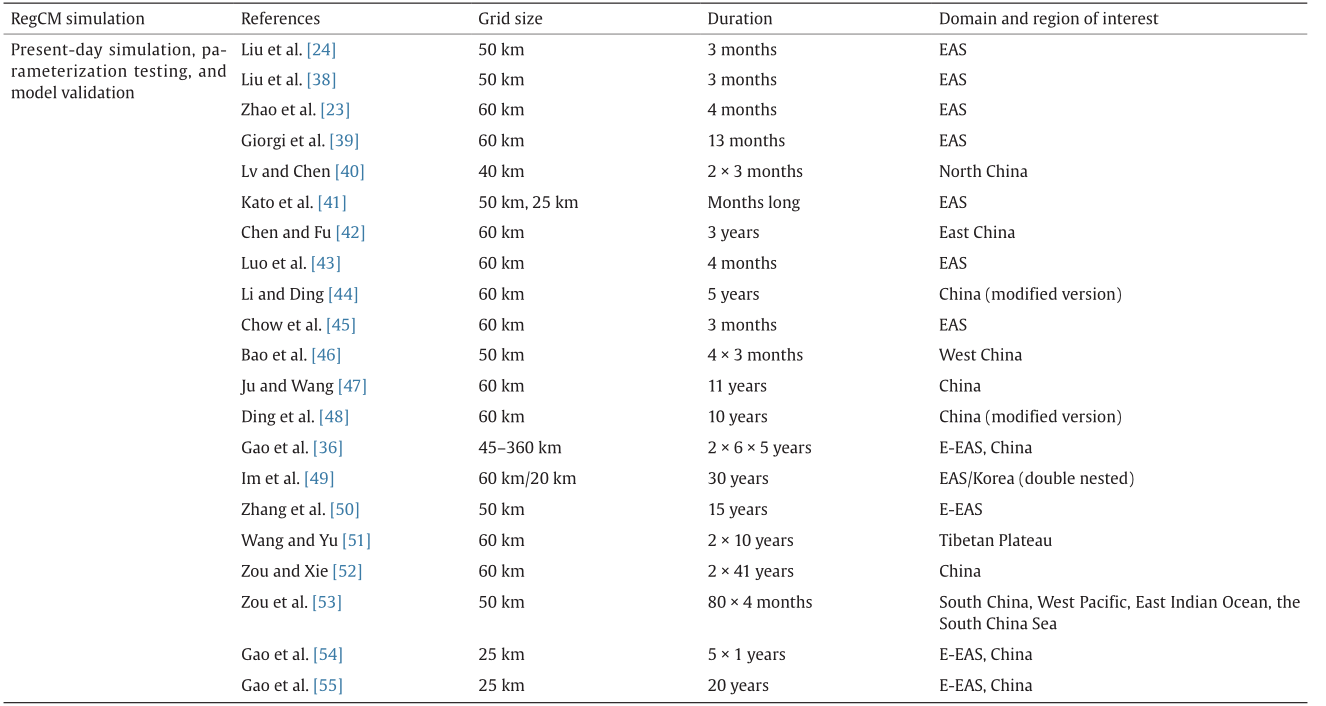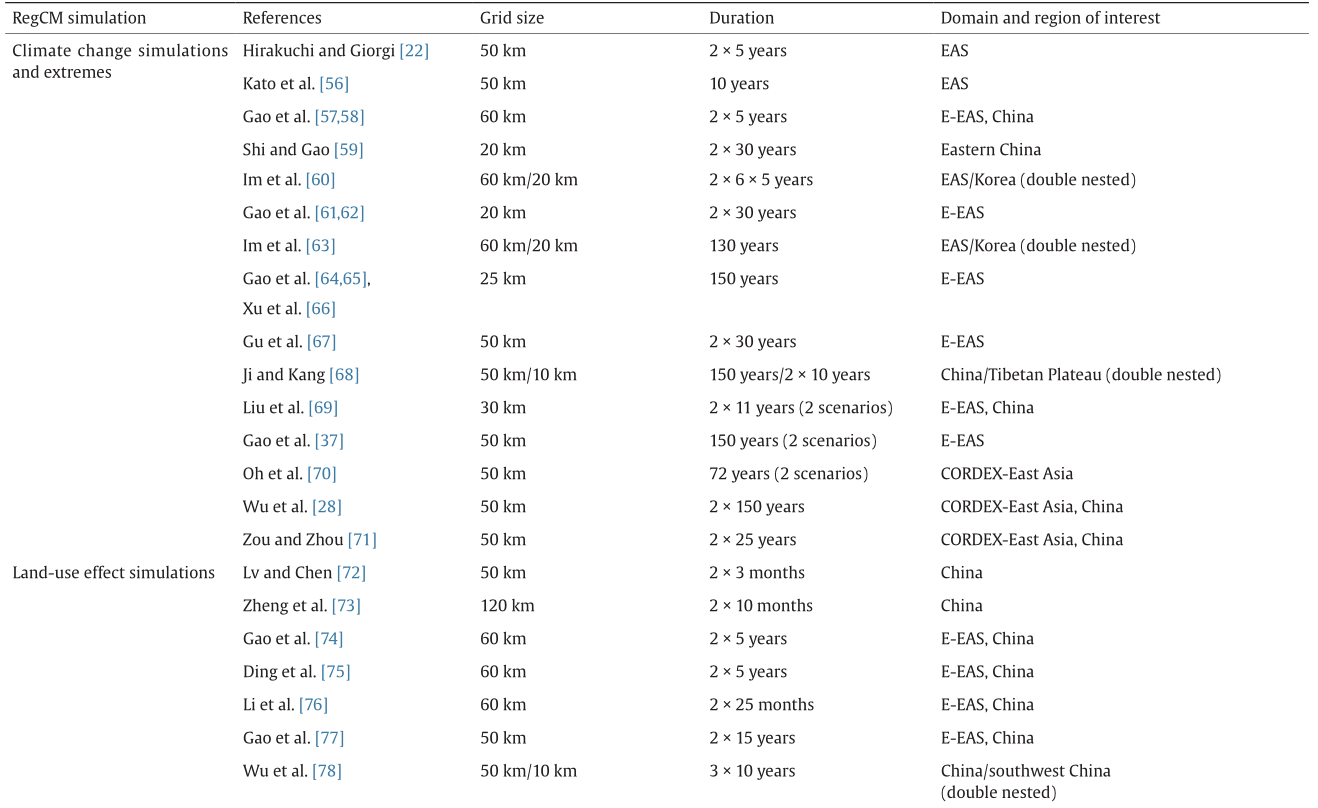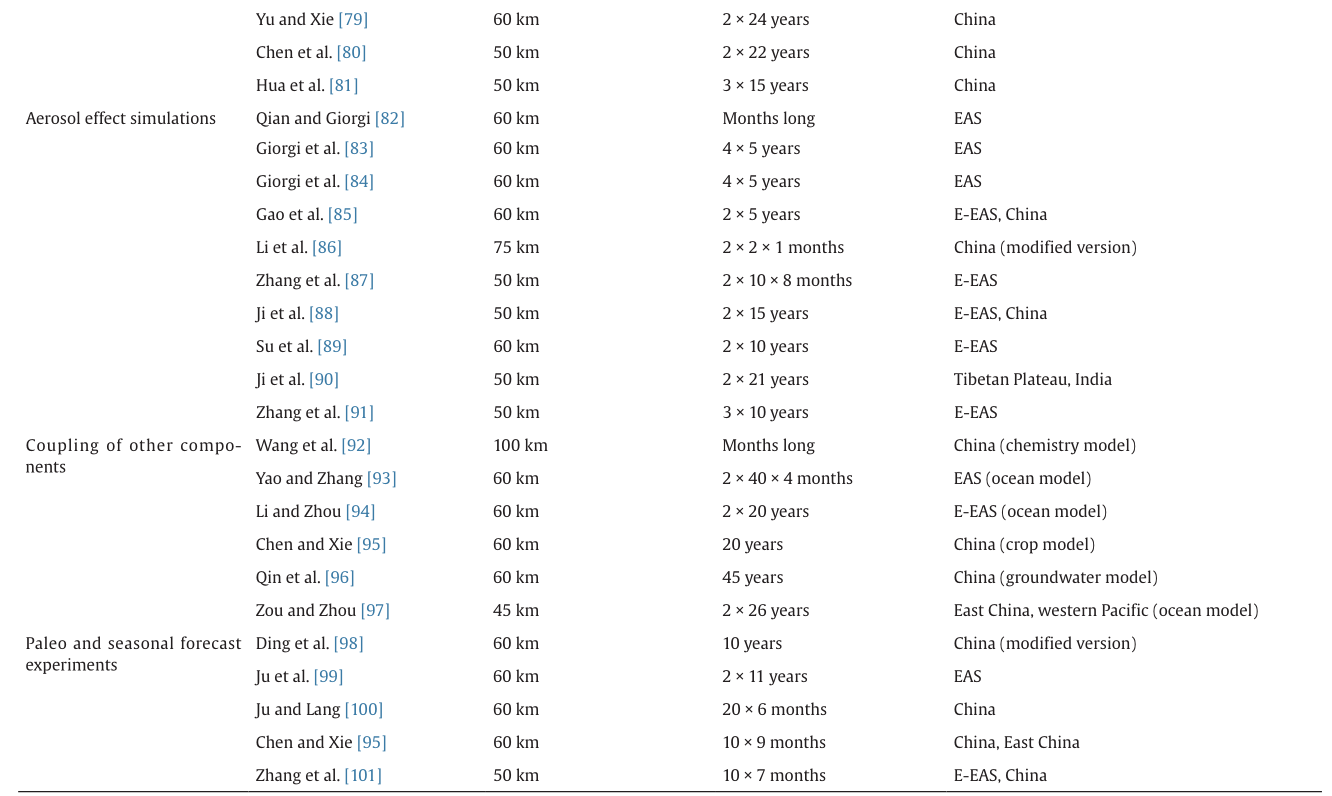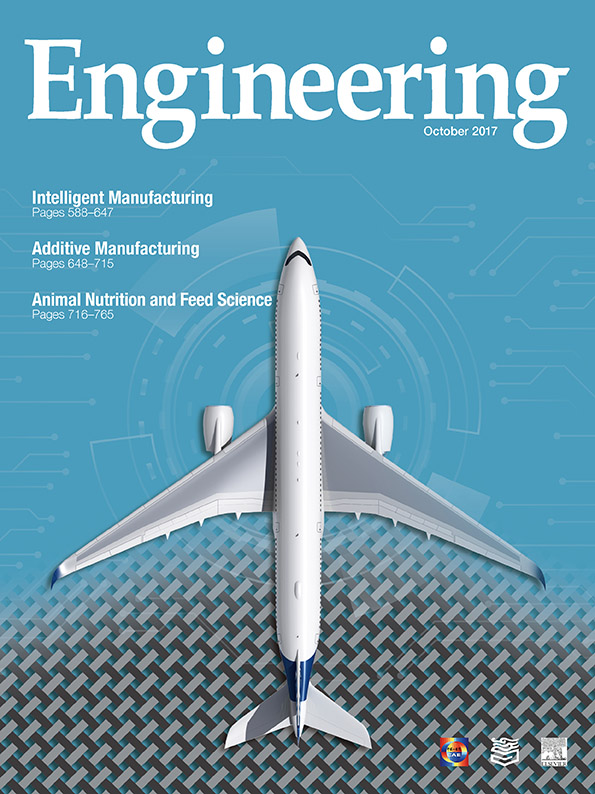《1.Introduction》
1.Introduction
During the last decades, regional climate models (RCMs) have been increasingly used to produce climate information at scales finer than those of global climate models (GCMs) over regions around the world [1]. The first RCM system developed for climate downscaling was the RegCM system, which originated in the late 1980s and early 1990s at the National Center for Atmospheric Research (NCAR) [2–4], and underwent a series of developments that resulted in successive versions such as RegCM2 [5,6], RegCM2.5 [7], RegCM3 [8], and the latest version, RegCM4 [9]. The RegCM system is currently developed and maintained at the Abdus Salam International Center for Theoretical Physics (ICTP). It is a public open source code and it is used by a wide research community forming the so-called Regional Climate Research Network, or RegCNET [10]. The model can be applied to all regions of the world [9] and is being developed into full coupled regional earth system model capability via coupling with models of the ocean [11,12], lakes [13], aerosol [14], desert dust [15],chemistry [16], hydrology [17], and land processes [18].
One of the continental areas where RCMs can be especially valuable is East Asia, which is characterized by complex topography, coastlines, and land-use distributions, as well as by regional circulations that impact local climates (monsoons, tropical storms, etc.). The climate of East Asia is also strongly affected by anthropogenic forcings associated with the rapid economic development of Asian countries, such as aerosol emissions and land-use modifications [19,20]. In addition, simulation of the monsoon-dominated climate of East Asia has been shown to depend on model resolution—for example, regarding the positioning and timing of the summer monsoon rain band [21].
For these reasons, RCMs have been applied to the East Asia region from the very early stages of RCM development [22–25], and at an ever-increasing pace since then. At present, East Asia is one of the standard domains under the framework of the Coordinated Regional Climate Downscaling Experiment (CORDEX) [26,27], and large ensembles of climate projections for this domain are available [28,29].
Of the RCMs that are applied to East Asia (e.g., RIMES [30], IPRCRegCM [31], PRECIS [32], P-σ RCM [33], MM5 [34], and WRF [35]), the RegCM system is among the most commonly used. The first applications of the RegCM to climate change simulations over this region are documented by Refs. [22,24]. In particular, the latter study was the first to complete five-year present-day and 2 × CO2 time slices over an East Asia domain at 50 km grid spacing, with the model driven at the lateral boundaries by meteorological fields from the NCAR Community Climate Model (CCM1). Since then, different generations of the RegCM system have been used over East Asia for a multitude of applications, from process studies and climate projections, to simulations of aerosols and land-use change effects. These studies have also highlighted some systematic model biases that have led to substantial model developments aimed at improving the model performance.
The community of RegCM users over the region has steadily increased over the years, and various training workshops, including tutorial sessions, have been organized (e.g., the RegCM Training Workshop for Southeast Asia in May 2015 in Manila, Philippines, and training courses during the Third International Seminar on Climate System and Climate Change in July 2006 in Beijing, China) in addition to the regular biannual workshop series held at the ICTP. The RegCM community plans to increasingly apply the model to the East Asia region within the context of the CORDEX-East Asia initiative, with an additional emphasis on the interactions and feedbacks across different components of the climate system and on the effects of anthropogenic forcings. In view of this perspective, here we present a brief review of previous and ongoing RegCM applications to the East Asia region, along with plans for future relevant model developments. Our aim is to provide a document that can serve as a base reference for future model users within the region.
《2.A review of RegCM studies over the East Asia region》
2.A review of RegCM studies over the East Asia region
Table 1 [22–24,28,36–102] provides a list of studies using the RegCM system over the East Asia region, divided by type of study and sub-regional focus. The performance of the model for the region is of the highest concern; thus, many studies on model performance assessment and optimization have been carried out using simulations driven either by reanalysis of observations or by GCMs. These studies have shown that the RegCM reproduces the main characteristics of present-day climate over the region quite well. Of particular interest is the conclusion that the model is able to improve fundamental GCM biases in the simulation of the East Asia summer monsoon. In fact, different generations of GCMs have shown a large bias in simulating the East Asia monsoon precipitation center, which is usually located too far north and west compared with observations (i.e., on the eastern edge of the Tibetan Plateau instead of on southeastern China). A series of experiments using different resolutions of RegCM2 driven by a GCM were conducted by Gao et al. [36], who found that this bias is mostly due to the coarse resolution of the GCM. The simulated precipitation pattern increasingly matched observations with increasing resolution, as shown in Fig. 1 [21], leading to the important conclusion that resolutions of 60 km or higher are needed in order to accurately simulate the evolution of the East Asia rain band. These findings were confirmed by further experiments with RegCM4 (e.g., Ref. [37]) as well as by other RCMs (e.g., Ref. [103]).
《Fig. 1》

Fig. 1. Spatial correlation coefficient between simulated and observed annual mean precipitation over China under different model resolutions (dashed line is the 0.99 significance level). (Modified from Ref. [21])
《Table 1》
Table 1 List of RegCM simulations over East Asia and China.

Table 1 (continued)


EAS indicates East Asia as defined in Ref. [102], which consists of eastern China, Korea, and Japan. E-EAS is the extended EAS, which is similar to the CORDEX-East Asia phase II domain with all of the China continent included.
Different options of the model physics parameterizations and/ or parameters have been tested in order to identify optimal model configurations over the region. For example, the Emanuel’s convection scheme has been found to provide a good performance in both RegCM3 [45] and the recent version, RegCM4.4, with the community land model (CLM) land-surface scheme [54]. In general, the RegCM system shows good performances in reproducing the monsoon (warm) season temperature and precipitation. However, relatively larger errors (similar to those of most GCMs) persist in the cold season, characterized by a warm bias at high latitudes, underestimated precipitation in the south, and overestimated precipitation in the north. As shown in Ref. [54], the precipitation center in DecemberJanuary-February in southern China is not well simulated by RegCM4, like most GCMs [104,105]. In addition, a similar bias exists in the ERA-Interim reanalysis, albeit to a lesser extent, indicating the difficulties in simulating winter precipitation over the region. Surface characteristics such as infrared emissivity have been shown to possibly improve the simulation of winter temperatures [106].
The RegCM system is widely used in downscaling GCM climate change projections over East Asia. Typically, compared to the driving GCMs, the model not only shows more detailed geographical features, but also provides an improved representation of the largescale precipitation patterns for present-day conditions. Concerning future precipitation change projections, Gao et al. [61,65] showed that the RegCM system introduces a fine-scale topographically induced structure of the signal; however, it also simulates some significantly different broad-scale change patterns compared with the driving GCMs. In these studies, while the driving GCMs simulate a predominant increase of monsoon precipitation in agreement with most other GCM projections, extended areas of decreased precipitation are projected by the RegCM4. Similarly, different change patterns in eastern China are found when the RegCM is driven by different GCMs. These results indicate that the uncertainties in the monsoon precipitation projection over this populated region are still large and thus require the completion of large multi-GCM/RCM ensembles in order to be fully characterized. The RegCM has also been one of the first RCMs to be run at relatively high resolution over some East Asia sub-regions (such as Japan and Korea) using the double nested approach [41,60,63], which showed how this application can provide detailed information on how topography and coastlines can affect the climate signal over these areas.
One of the applications of the RegCM system over East Asia has been the investigation of land-use effects associated with a long history of agricultural activities and high population. The land-use experiments conducted to date include simulations using idealized simple vegetation changes from one type to another over extended areas (e.g., from desert to trees or vice versa), comparisons between potential vegetation cover and current land use, and studies of land-use change impacts over the decades of the late 20th century in response to rapid economic development during that period. All the studies indicate the significant effects of land use on climate over the region. However, different conclusions were derived concerning the spatial detail and magnitude of these effects, calling for the use of multiRCM inter-comparison experiments. Furthermore, it was noted that the land cover data from international databases usually show large biases over China. For example, the dominant bare soil cover over the Tibetan Plateau in the default land type of the CLM dataset [107] does not represent the predominant observed grass cover over the region. The use of more reliable land cover data based on local datasets has indeed been shown to improve the model simulation [108].
The climatic effects of anthropogenic aerosols over China have drawn increasing attention during the last decades due to the rapidly increasing pollution emissions associated with the industrial and economic development of the country. The RegCM system was the first RCM that was applied to the study of this issue and, in particular, the first model in which radiatively interactive aerosols were coupled to an RCM over East Asia, including both direct and indirect aerosol effects [82–84]. Simulations by the RegCM system have shown a significant cooling and inhibition of precipitation due to the aerosols, especially over the most industrialized regions such as the Sichuan Basin in central/southwestern China. Due to the complexity of aerosol effects, further investigations are needed in order to more quantitatively evaluate the effects of particulates on precipitation, especially concerning the interactions with clouds, and work with the RegCM system has paved the way in that direction. East Asia is also one of the most prominent regions of dust generation, especially over the deserts in western China and Mongolia. Several simulations conducted including dust aerosol have shown a good performance by the RegCM system in reproducing the spatial and temporal variations of near-surface concentration, mass load, optical depth, and emission of dust aerosols from the main source regions (e.g., Ref. [87]).
Research has been carried out in China on the coupling of RegCM4 with other components of the climate system, including different ocean models, crop models, and models for underground water tables. For example, results show that coupling RegCM with interactive oceans can greatly improve the model’s capability to simulate the precipitation climatology and interannual variability over the northwestern Pacific [97]. Other applications of the RegCM include paleoclimate studies and seasonal forecast experiments. For the latter, Zhang et al. [101] found improved skill with the use of the RegCM over some specific areas and years of East Asia and during specific years. However, many more investigations are needed for the future application of the model to real-time seasonal forecast in China.
《3.Future perspectives for model development and application over the East Asia region》
3.Future perspectives for model development and application over the East Asia region
The physical and parameter configurations of RegCM4.4 over East Asia are recommended by Gao et al. [54,55]. To be more specific, the model performs “best” over this region when using the Emanuel’s convection scheme and CLM land-surface scheme, along with updated land cover data based on Chinese datasets [108]. In the meantime, the RegCM system is undergoing various developments that have direct relevance for application to the East Asia region. Compared with the version described by Giorgi et al. [9], two new cumulus convection schemes have been added, those of Tiedtke [109] and Kain and Fritsch [110], which show particularly encouraging results in the simulation of convection in tropical regions. A non-hydrostatic version of the dynamical core has been implemented, as was done for the mesoscale model MM5 [111], along with a full cloud microphysics scheme that explicitly accounts for cloud water and ice, rain, and snow variables [112]. This allows the application of the model to experiments at very high resolutions, on the order of a few kilometers.
Concerning coupled model development, an updated version of the MIT-OGCM ocean model is now operationally coupled to the RegCM4 and has been tested over various regions, along with the CLM4.5 land-surface scheme [18], which includes, among others, options for the representation of urban environments and dynamical vegetation response to climate forcing. Interactive coupling of the land hydrology model CHYM [17] has also been completed and is currently being tested. Coupling with a marine biogeochemistry model is also under way.
Extensive application of the new version of RegCM4 over the East Asia and China region is planned, in addition to the issues discussed in Section 2. To date, only limited non-hydrostatic studies have been performed at resolutions of a few kilometers, and it may be difficult to conduct such simulations over the whole East Asia domain due to the huge computer cost. However, studies over some specific areas will help with better understanding local climate conditions and producing local-scale climate change projections for impact studies. Enhanced fine-scale surface information can also be achieved through the use of the land sub-grid scheme available in RegCM4 [113]—a model capability that has been somewhat underused so far. Some preliminary tests of the RegCM4 with the new cloud microphysics scheme have shown encouraging results in reducing the warm bias in high latitudes in the cold seasons, particularly because of the improvement in the simulation of cloudiness. Although this result needs further verification, the final outcome will provide useful suggestions for the development of other RCMs, as well as of GCMs. As part of the next phase of CORDEX activities, it is planned to increase the RCM resolution over the continental-scale CORDEX domains to 10–20 km [1], so the RegCM4 will need to be further tested and optimized over the region at these resolutions. Simulations will be conducted using the configuration under the CORDEX frame. The inter-comparison of the RCMs will also help with better understanding the model’s behaviors in order to enable its further improvement over the region.
In summary, many simulations have been conducted with the RegCM system over the East Asia region, with very valuable outcomes for modeling activities in the region. Application and development of the model will continue to promote climate studies in the area, including climate change projections, land-use effects on climate, aerosol and pollution studies (i.e., distribution, transport, and effects on climate), and paleoclimate and seasonal forecasts. It is also expected that a new generation of RegCM simulations over the East Asia domain will provide a strong contribution to the Sixth Assessment Report (AR6) of the Intergovernmental Panel on Climate Change (IPCC), to CORDEX, and to the applications in impact and vulnerability studies.
《Acknowledgements》
Acknowledgements
The authors thank Dr. Jie Wu and Dr. Ying Shi for their contributions on collecting and compiling the references. The research was supported by the National Key Research and Development Program of China (2016YFA0600704).
《Compliance with ethics guidelines》
Compliance with ethics guidelines
Xuejie Gao and Filippo Giorgi declare that they have no conflict of interest or financial conflicts to disclose.














 京公网安备 11010502051620号
京公网安备 11010502051620号




